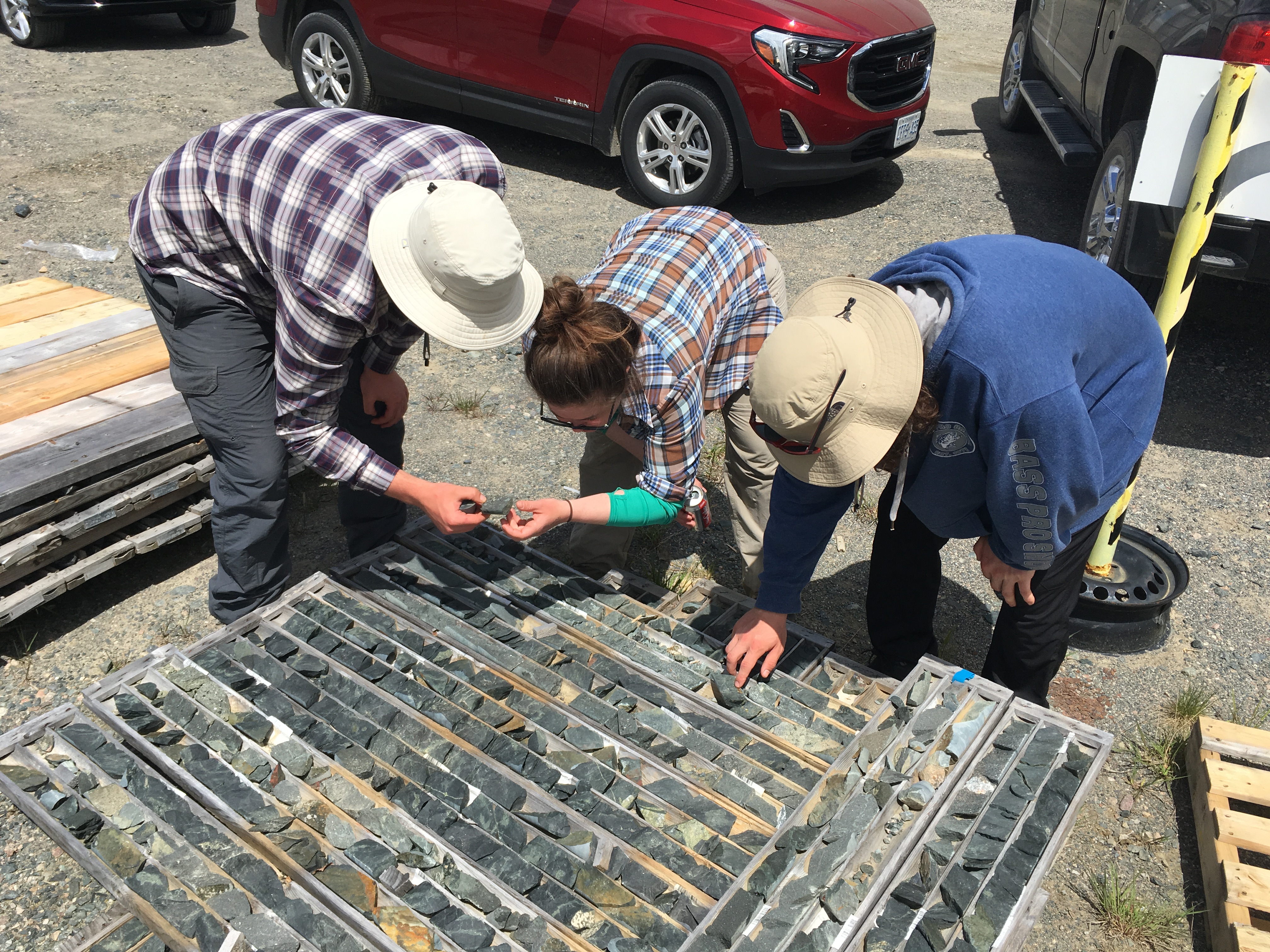Metal Earth Transect Scale Project:
Abitibi, Cobalt
Project Information
Project Title:Structural and stratigraphic controls on mineralized veins in Cobalt, Ontario/ Cobalt Transect Research Location:Cobalt, Ontario Research Team:Dr. Shawna Elizabeth White, Postdoctoral Fellow, MERC, Dr. Ross L. Sherlock, Director of MERC, Dr. Daniel Kontak, Full Professor, Harquail School of Earth Sciences, Louise Rush, MSc Candidate Laurentian University. |
Project Status:Active Contact:Postdoctoral Fellow, Mineral Exploration Research Centre, Laurentian University
|
Academic Collaborators:
Dr. Mike Hamilton, Professor, University of Toronto
Industry Collaborators:
Frank Santaquida, VP Exploration, First Cobalt Corp.
Image Caption: Shawna White, Brad Piche (field assistant), and Ryan Wells (field assistant) looking at the First Cobalt Corp. drill core that Louise Rush (MSc) will be sampling in 2019.
Scope of Project:
The work carried out along the Cobalt Transect represents a portion of the larger Metal Earth project carried out by the Mineral Exploration Research Center. Metal Earth is a multiyear, multidisciplinary collaboration focused on determining the factors that control mineralization within Archean greenstone belts. As part of this larger initiative, our work aims to determine the structural and stratigraphic controls on Ag-Co arsenide veins hosted in Archean volcanic and Paleoproterozoic sedimentary units in the Cobalt region of Ontario, using a combination of mapping, geophysical, and geochronological data.
Geologic mapping was carried out in two main areas just west of Lake Timiskaming (Cobalt and South Lorraine regions) during the 2018 field season. Areas were chosen, based on lithologies exposed, economic potential, and proximity to geophysical surveys (2D seismic reflection, gravity and MT) carried out by Metal Earth in 2017. Particular attention was paid to structural measurements to aid in determination of deformation history of the region. 2D aeromagnetic data was also interpreted alongside new geological observations and these results were compiled in ArcGIS and used to better constrain existing regional maps. Other historical data (including vein orientation and location) were added to the database to aid in interpretations.
Samples for geochronology, whole rock geochemistry, petrography and structural analysis were collected during the 2018 field season. A total of 40 samples (from Archean volcanic basement) were sent to ALS for whole rock geochemistry and results are currently being interpreted. Approximately 80 thin-sections were made (by Vancouver Petrographic) for petrographic and structural analyses. A total of 5 felsic volcanic and 1 granitic sample from Archean basement have been sent to Mike Hamilton at the U of T for TIMS analyses. This work is ongoing and results are being interpreted as they are obtained. 9 Detrital zircon mounts were made in house (3 Proterozoic Huronian, 3 Archean Timiskiming, 3 Archean interflow sedimentary units). All mounts have been imaged (using SEM JEOL6400) and U/Pb isotopic ratios determined using LA-ICP-MS (with a Neptune Plus High Resolution Multicollector). Results are being used for interpretations regarding both provenance and max. depositional age of all geologic successions outcropping in the region.
Anticipated Outcomes:
The team anticipates the production of multiple publications and reports for the ongoing work in the Cobalt region. The following is a list of key questions which they hope to address, each in a peer reviewed journal:
- What are the structural and stratigraphic controls on Ag-Co arsenide veins? Are they controlled by Archean basement structures? What role do the major Northwest striking faults in the region play with respect to fluid migration/vein emplacement?
- What is the nature of the Archean basement in Cobalt? Preliminary geochronological and geochemical data suggest possible correlations with volcanic basement in the Pontiac Terrane. Can we define a new (younger) volcanostratigraphic unit within the Abitibi?
- What is the provenance of the Huronian Supergroup in Cobalt, Ontario? Is there a provenance shift across the Coleman-Lorrain boundary? If so, what might this tell us about basin evolution?
- What is the provenance of interflow sedimentary units within the Archean volcanic basement succession? Are they locally derived? Are there ages consistent with derivation from local basement sources (determined in the work using TIMS) or more distal sources not present in the embayment? These data might provide information about geology hidden beneath thick sedimentary packages of the Huronian and adjacent Pontiac.
Cobalt Transect Map:
Transect Research Projects
Project Title: |
Researcher: |
|
Tracing the origin of metal and fluids in the enigmatic Ag-Ni-Co-As+/-(Bi,U) deposits of Cobalt, Ontario |
Louise Rush, MSc candidate, Laurentian University |
Related Documents/News:
Metal Earth GeoHub - Cobalt Related Documents
Ontario Geological Survey Summary of Field Work 2018




